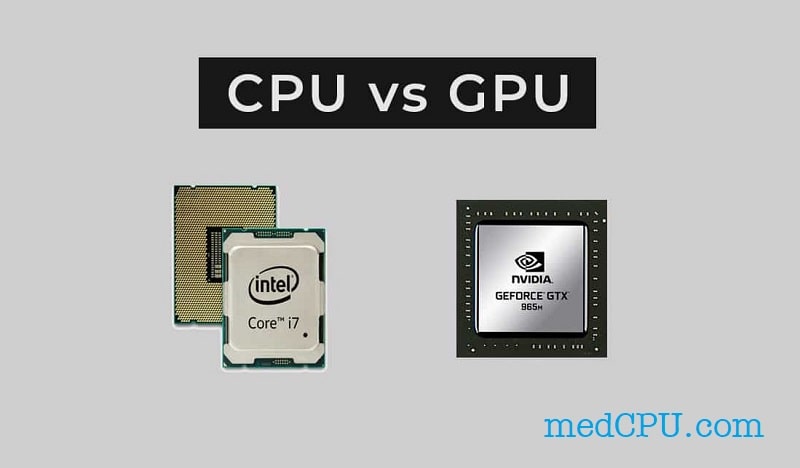Are you confused between GPU vs CPU? Then you come to the right place.
A Central Processing Unit is a general-purpose, latency-optimized processor that can handle many distinct tasks sequentially. A Graphics Processing Unit is a throughput-optimized specialized processor for high-end parallel computing.
But, they are more complicated. It is more difficult to decide whether your GPU or CPU should be upgraded. Medcpu can help you make that decision. Let’s explore!
CPU and GPU overview
What is a CPU?
The Central processing unit (CPU) is made up of millions of transistors. It can be divided into multiple cores for processing and is often called the brain of the computer. The CPU is an essential component of modern computing systems.
It executes all commands and processes required for your computer and the operating system. It is also crucial in determining the speed at which programs run, whether you are surfing the internet or creating spreadsheets.

What is a GPU?
A Graphics processing unit (GPU) is made up of many smaller cores that are more specialized. The cores work together to deliver huge performance when processing tasks can be split up and processed by many cores.
Difference between GPU vs CPU
Both GPUs and CPUs share many commonalities. Both are crucial computing engines. Both are microprocessors based on silicon. Both can handle data. However, CPUs and GPUs are different in their architectures and designed for different purposes.
The CPU can handle a variety of workloads, including those that require high latency and per-core performance. The CPU is a powerful execution engine. It focuses smaller cores on specific tasks to get things done quickly. It is uniquely equipped to handle jobs such as running databases and serial computing.
The first GPUs were ASICs that were designed to speed up specific 3D rendering tasks. These fixed-function engines became more programmable over time and more flexible.
Graphics and the ever-more lifelike visuals in today’s top games are still their primary function. However, GPUs have evolved to be more general-purpose parallel processors that can handle a wider range of applications.
Read also:
For GPUs, Computer Graphics First of Many Apps
Computer graphics was only one of many killer apps. It’s also what has driven the massive R&D engine behind GPUs forward. This allows GPUs to outperform other niche-market chips with more specific functions.
CUDA is another factor that makes all this power available. The parallel computing platform was first released in 2007. It allows coders to take advantage of GPUs’ computing power for general-purpose processing by simply inserting commands into their code.
This has allowed GPUs to flourish in new areas. With support for a growing number of standards, such as Kubernetes or Dockers, applications can be tested on a cheap desktop GPU. Then they can be scaled up to faster, more complex server GPUs.

CPUs and the End of Moore’s Law
NVIDIA invented GPUs in 1999 to help Moore’s Law end.
Moore’s law states that the number of transistors that can fit into an integrated circuit will increase by about two per year. This has led to a rapid rise in computing power over the past decades. However, this law has reached hard physical limits.
The GPUs allow you to accelerate applications, such as graphics and supercomputing. This is possible by splitting tasks between multiple processors.
According to John Hennessey, David Patterson, and the authors of Computer Architecture: A Quantitative Approach, the seminal textbook about microprocessors, such accelerators are crucial to the future development of semiconductors.
What is more important for PC gaming: CPU or GPU?
The GPU is widely regarded as the most important component of PC gaming. The GPU renders images, scenes, animations, and other graphics that you see. The GPU is required to render fast-paced games like today. These games also take advantage of the many cores and threads offered by newer CPUs.
Both the GPU and CPU are crucial in their ways. Both a powerful GPU and a smart CPU are required for demanding games. However, the importance of these components for PC gaming will depend on their use and what games they are used for.
The GPU’s tasks can’t do well with those that CPUs have to perform, such as AI functionality for non-player characters (NPC). However, there are many tasks that the GPU can do better.
Some games are more responsive with more cores than others because they use them. Some games may run better with one core, but they are programmed to use only one core. A faster CPU will make the game run more smoothly. It won’t have enough power to run properly, and it will become laggy.
Read also:
Things to consider when upgrading your GPU
Here are some things to keep in mind if you’re thinking about upgrading your GPU.
Monitor resolution: Today’s graphics cards meet the minimum requirements of 1080p resolution. To match any monitor with resolutions above 1440 pixels, including WQHD, QHD, UHD, and 4K, you’ll need a high-end graphics card.
Refresh rate: A card with a higher refresh rate (144 Hz or more) will be required to maximize its potential. A monitor with a 60Hz refresh rate does not require a more powerful and expensive graphics card.
Memory: It’s not just the CPU that matters. For intense gaming at 1080p at high resolution, your GPU should have at least 4GB and 8GB for mega-gaming at 4K.
Form factor: Make sure to check the specifications of the graphics card. The height, length, and girth of your GPU are important dimensions. It must fit into your gaming system.
Graphic cards: including single-slot, dual-slot, and full-height. To avoid disappointment and unnecessary costs, do your research before you install it.
AMD FreeSync and NVIDIA GSync: These technologies sync refresh rates between your GPU and monitor to reduce tearing. Before you buy a new video card, make sure you know which technology your monitor supports.
VR support: You will be using the Oculus Rift or HTC Vive VR platforms to need minimum mid-range cards like the NVIDIA GTX 1060/1070/1080 or the AMD Radeon RX570/580.
FAQs regarding CPU and GPU
1. Can GPU be used as a CPU?
You can use a GPU to replace a CPU for many tasks, but it can never function as a CPU. The Central Processing Unit is also known as the CPU. The CPU, also known as the computer’s brain, is where all the processing power and calculations are performed.
Read more:
https://www.quora.com/What-are-the-differences-between-CPUs-and-GPUs
2. Why is the GPU faster than the CPU?
GPUs can be faster than CPUs because of their bandwidth. The CPU uses a lot of memory to train the model because of large datasets. A dedicated VRAM memory is available for the standalone GPU. This allows the CPU’s memory to be used for other purposes.
3. Is GPU a graphics card?
Although GPU (or video cards) are often interchangeably used, there is a subtle difference between them. A graphics card is an add-in board that contains the GPU, much like a motherboard. There are two types of GPUs: discrete and integrated.
Conclusion
There you have it – the comparison between CPU vs GPU. The GPU can be the most costly part of your gaming build. If you have a tight budget, it may be worth saving some money for your CPU.
Your gameplay may suffer if you spend too much money on the GPU and not enough attention to the CPU. We hope you will like this post. Please leave a comment below if this article helped you.

Eyal Ephrat serves as the co-founder and CEO of medCPU.com, where technology is making significant strides in the field of medicine. Through his experience in purchasing PC and laptop equipment and various other tech products, Eyal Ephrat contributes valuable insights to medCPU’s mission.
